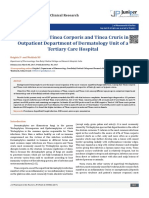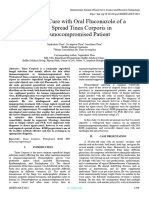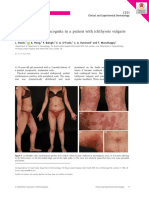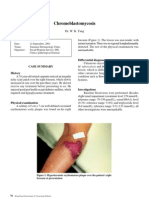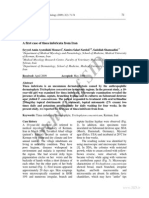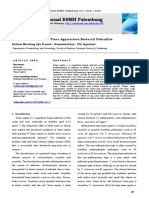663 1041 1 SM
663 1041 1 SM
Uploaded by
Ivan FirmansyahCopyright:
Available Formats
663 1041 1 SM
663 1041 1 SM
Uploaded by
Ivan FirmansyahOriginal Description:
Original Title
Copyright
Available Formats
Share this document
Did you find this document useful?
Is this content inappropriate?
Copyright:
Available Formats
663 1041 1 SM
663 1041 1 SM
Uploaded by
Ivan FirmansyahCopyright:
Available Formats
CASE REPORT
TINEA CORPORIS AND TINEA CRURIS CAUSED BY
TRICHOPHYTON MENTAGROPHYTES TYPE GRANULAR IN
ASTHMA BRONCHIALE PATIENT
Arif Risdianto, Dirmawati Kadir, Safruddin Amin
Department of Dermatovenereology Medical Faculty of Hasanuddin University / Wahidin
Sudirohusodo Hospital Makassar
ABSTRACT
Tinea corporis is a fungal infection of the skin dermatophytes
glabrosa except the hands, feet and groin, while tinea cruris is a
common infection in the groin area, genitals, pubic area, perineum and
perianal skin, which causes the fungus most often derived from the
genus Trichophyton, Microsporum and Epidermophyton.
It was reported one case of tinea corporis and tinea cruris caused by
Trichophyton mentagrophytes type granular on a man of 54 years old.
Diagnosis was established based on clinical features, direct microscopic
examination with kalium hidroxyde (KOH) 10% and culture in vitro.
Patients was treated with oral ketokonazole and myconazole2% cream
with clinical and mycologycal improvement.
Keywords: tinea corporis, tinea cruris, trichophyton mentagrophytes
type granular
Address for correspondence : Arif Risdianto, dr., Department of Dermatovenereology Medical Faculty of Hasanuddin University / Wahidin
Sudirohusodo Hospital Makassar , Blok Z /7 Perum Citra Sudiang Indah Jl. Sukhoi Makassar, South Sulawesi, Indonesia 90242,
arif_risdianto@yahoo.com
31
Arif Risdianto
tinea corporis and tinea cruris caused by trichophyton mentagrophytes type granular in asthma bronchiale patient
INTRODUCTION
with potassium hydroxide (KOH) and
cultured in vitro.(10, 11) Direct microscopic
examination showed long and branched
hyphae which is characteristic of the
dermatophyte infection but the level of
specificity and sensitivity is less. Cultured
in vitro by using Saboraud Dextrosa Agar
(SDA) can be used to determine the
characteristics of the macroscopic and
microscopic organisms is diagnostically
specific techniques but takes a long
time.(11, 12)
Treatment
of
dermatophyte
infections usually respond well to topical
antifungal within 2-4 weeks. If patients
have extensive lesions or fail with topical
treatments, anti-fungal preparations can
be administered orally, among others,
griseofulvin, ketoconazole, itraconazole
and terbinafin.(12, 13)
Reported one case of tinea corporis and
tinea cruris in a man aged 54 years old
caused by Trichophyton mentagrophytes
granular type that responds well to oral
ketoconazole and topical miconazole 2%
cream.
Dermatophytosis is a superficial fungal
infection caused by dermatophyte fungi on
keratin-containing tissues, such as the
stratum corneum, hair and nails.(1, 2)
Fungal infection that often causes
dermatophytosis is a genus Tricophyton,
Microsporum and Epidermophyton.(3, 4)
Tricophyton mentagrophytes, Tricophyton
rubrum and Microsporum canis are the
causative agent of tinea corporis and tinea
cruris most frequently.(5) Dermatophytosis
infection is thought to have attacked 2025% of the population worldwide, and its
incidence continues to rise.(6, 7)
Tinea corporis is a dermatophyte fungal
infection of the skin glabrosa except the
palms, feet and groin, while tinea cruris is
a common infection on the groin area,
genitals, pubic area, perineum and
perianal skin. Clinically be found only tinea
corporis or tinea cruris, but can also be
found both.(1, 5, 8) Transmission can be
through direct contact with an individual or
an infected animal or indirectly through
objects containing squama infected.(9)
Covered clothes and high humidity
associated with the frequency and severity
of eruptions dermatophytosis.(1, 5)
Clinical picture of tinea corporis varied,
can be demarcated erythematous plaques
with more rising edge and the center of the
lesion tends to heal (central healing).
Adjacent lesions may merge to form a
pattern or polycyclic girata. Lesions of
tinea corporis can also serpigininous and
annular (ringworm-like). Tinea cruris which
appears in the form of multiple
erythematous papules demarcated, with a
more elevated edges. Usually itchy or
painful case of maceration and secondary
infection.(1, 5, 10)
Investigations to establish the
diagnosis of a dermatophyte infection can
be done by direct microscopic examination
CASE REPORT
A man aged 54 years old ,
came to
dermatology clinic Salewangan hospital,
Maros with complaints itchy red patches
on the chest, back, buttocks since 1 year
ago. Originally appeared in the form of red
spots on the chest area, getting larger
became red patches and scales on top
then spread to the upper back and
buttocks . These complaints were often
perceived recurrent. Itching is felt
especially when sweating. A history of
drug treatment in the form of itching CTM
and betamethasone ointment purchased
at a pharmacy, but
no clinical
improvement. Patients admitted often
wear a jacket every day. History contact
with pets denied. History therapy for
asthma, patient took prednisone since 24
32
IJDV
Vol.2 No.2 2013
33
Arif Risdianto
tinea corporis and tinea cruris caused by trichophyton mentagrophytes type granular in asthma bronchiale patient
years ago . History of the same disease in
the family denied. Denied a history of
diabetes mellitus.
On physical examination seem
mild pain, compos mentis, nutrition
enough impression, with blood pressure
140/85 mm Hg, pulse 84 beats / min and
breathing 20 times / min. Dermatological
status on the region of anterior thoracic
and cervical posterior looks erythematous
plaques, demarcated,
erythematous
papules on the edge of lesions. At the
center of the lesion are experiencing the
healing area (central healing) and
squama. At the gluteus and supra pubic
region looks hyperpigmentation plaques,
34
IJDV
Vol.2 No.2 2013
demarcated, erythematous papules on
the edge of lesions . At the center of the
lesion are experiencing the healing area
(central healing), and squama. (Figure 1)
Diagnosis was tinea corporis and tinea
cruris.
Direct microscopic examination of
skin scrapings by using 10% KOH solution
gives an overview long and branched
hyphae (Figure 2). Based on anamnesis,
physical examination, and examination of
skin scrapings with KOH 10%, patient
was diagnosed tinea corporis and tinea
cruris.
On day 14 therapy , clinical pictures showed macular hypopigmentation
and hyperpigmentation. Re-examination
of KOH 10% long and branched hyphae
not found, therapy discontinued.(Figure 6
a,b,c,d).
DISCUSSION
Diagnosis of tinea corporis and
corporis caused by Trichophyton mentagrophytes granular type was established
based on the patient history, physical
examination and
direct microscopic
examination with 10% KOH preparations
using skin scrapings followed specimens
culture examination to determine the
cause of dermatophytosis species.
Culture examination conducted
with specimens of skin scrapings on media
Saboroud's Dextrose Agar (SDA). Macroscopically visible presence of white to
creamy-colored colonies with a pile of
cotton surfaces such as fine and coarse
granular. (Figure 3 a,b,c,d) On microscopic examination by using Lactophenol
Cotton Blue (LCB) of culture appears
microconidia are clustered, rarely macroconidia shaped like a cigar, sometimes
there is a spiral hyphae. (Figure 4 a,b)
Description of macroscopic and microscopic colonies according to the dermatophyte species Trichophyton mentagrophytes granular type. Final diagnosis was
tinea corporis and tinea capitis caused by
Trichophyton mentagro-phytes granular
type.
In the history of a male patient 54
years with complaints of itching on the
chest, back, buttocks and above the pubic
experienced since 1 year ago, white
scales, often recurrent. Itching is felt
especially when sweating and patients
admitted often wore jacket. In accordance
with the literature that tinea corporis and
tinea cruris generally provide complaint
and intensified itching when sweating.
High humidity, excessive perspiration and
clothing that covered a predisposing factor
for the emergence of dermatophyte
infection.(5, 8, 14) Patients often have a
history of taking prednisone for asthma
hospital since the age of 20 years and
often recurred. Immunosuppression drugs
may increase the risk of dermatophyte
infection.(15) In one study by Woodfolk
indicates that there is a very strong
relationship
between
asthma
with
dermatophyte infections especially those
caused by the genus Trichophyton. This
study showed that Trichophyton infections
may trigger the development of asthma
and other allergic diseases or otherwise
through the mechanism of immediate
hypersensitivity and delayed hypersen-
Management therapy oral ketoconazole 200 mg per day and topical
miconazole 2% cream applied twice a day.
On day 10 therapy , clinical pictures
showed hypopigmentation and hyperpigmentation macules and no scales.
Topical therapy with miconazole 2% be
continued. Re-examination of KOH 10%,
long and branched hyphae not found
.(Figure 5 a,b,c,d).
35
Arif Risdianto
tinea corporis and tinea cruris caused by trichophyton mentagrophytes type granular in asthma bronchiale patient
sitivity. Jones mentions the theory that
exposure to fungal antigen can induce an
allergic inflammatory response in the
respiratory tract.(16, 17) In another study
showed that asthma-up with dermatophyte
infection especially by the genus
Trichophyton, after treatment with oral
anti-fungal medication then asthma has
improved.(18)
and fungal species most commonly
causes tinea cruris is T. rubrum, T.
mentagrophytes and E. floccosum.(1, 4) In
this patient, tinea cruris is suspected that
autoinoculation result of tinea corporis.
This is consistent with the literature that
tinea corporis often occurs concurrently
with other dermatophyte infections such as
tinea capitis and tinea pedis.(23) In one
study in the Section of Urology in Turkey
says that there are about 7.7% of patients
with tinea capitis is always accompanied
by tinea corporis and 33.3% were caused
by Trichophyton mentagrophytes.(24)
On physical examination, thoracic
region gluteus and supra pubic showed
erythematous plaques, hyperpigmentation,
demarcated, erythematous papules on the
edge, central healing and squama. This is
consistent with the literature which states
that tinea corporis and tinea cruris can be
acute or chronic. Acute abnormalities that
can give a picture of macular and erythematous plaques with erosion and sometimes there is excoriation, and there is a
central healing. When the disease is
chronic then effloresensi visible only along
hyperpigmented macules or plaques scaly.
(1, 4, 8, 14)b
Fungal cultures in vitro was
conducted to determine the cause of
dermatophytosis species. Source of
specimens derived from skin scrapings,
planted in Saboraud's dextrose agar
(SDA) at 25 - 30 C, and the colony will
grow normally within 7-28 days.(1, 10, 19, 20)
In this case, it appears the macroscopic
colonies are white to creamy colored with
a a pile of cotton surfaces such as fine and
coarse
granules.
On
microscopic
examination by using Lactophenol Cotton
Blue (LCB) of culture appears the
microconidia
are
clustered,
rarely
macroconidia shaped like a cigar,
sometimes there is a spiral hyphae.
Description of macroscopic and microscopic colonies according to the dermatophyte species Trichophyton mentagrophytes granular type.(1, 21, 22) Tinea corporis
is most often caused by the species T.
mentagrophytes, T. rubrum, and M. canis
Therapy in this case
oral
ketoconazole 200 mg once daily for 2
weeks and miconazole 2% cream and
obtained
clinical
improvement
and
mycological
improvement.
Systemic
antifungal therapy is indicated if the
lesions are extensive or fails to topical
treatment, recurrent or chronic, or if the
25)
skin
condition
gets
worse.(4,
Ketoconazole is an antifungal azole class,
broad-spectrum and can be given to
patients who do not respond to topical
therapy. Mechanism of action of this drug
to inhibit ergosterol biosynthesis by
menginhibisi enzyme cytochrome P-450,
C-14--dimethylase responsible transform
lanosterol to ergosterol resulting in fungal
cell walls become permeable and the
destruction of the fungus occurs.(25-27) After
10 days of therapy, no complaints of
itching and red spots dissappeared as
well as negative KOH examination.
Imidazole group is quite effective topical
treatment for dermatophyte infec-tions.
Preparations are often used mico-nazole,
ketoconazole, clotrimazole, oxico-nazole,
and econazole. This recommend-dation
topical imidazole twice a day and is
usually used for 2 weeks for tinea corporis
and tinea pedis for 4 weeks. The
mechanism works by inhibiting the
36
IJDV
Vol.2 No.2 2013
Tehran, Iran, from 2000
IJDVL2009;75(2):142-8.
synthesis of ergosterol fungi that result in
defects in the fungal cell membrane.(25, 28,
29)
In this case was given topical therapy
miconazole 2% cream.
Non-medicamentosa management
and prevention of relapse of disease is
very important, such as reducing the
predisposing factors, namely temperature,
humidity and occlusion by advocating
wearing loose clothing and materials that
easily absorb sweat, dry off after a shower
and sweating, losing weight if obese, wash
contaminated clothing and avoid allergens
trigger asthma.(8, 10, 13)
2.
2005.
8.
Goedadi M, Suwito H. Tinea korporis dan
tinea kruris. In: Budimulja U, Kuswadji,
Bramono K, Menaldi SL, editors. Dermatomikosis superfisial. Jakarta: Balai Penerbit FKUI; 2004. p. 31-5.
9.
Adiguna
MS.
Epidemiologi
dermatomikosis
di
Indonesia.
In:
Budimulja U, Kuswadji, Bramono K,
Menaldi SL, editors. Dermatomikosis
superfisial. Jakarta: Balai Penerbit FKUI;
2004. p. 1-6.
10. Hay RJ, Ashbee HR. Mycology. In: Burns
T, Breathnach S, Cox N, Griffiths C,
editors. Rook's textbook of dermatology.
8th ed. Oxford: Wiley-Blackwell; 2010. p.
36.1-.15.
REFERENCES
1.
to
Verma S, Heffernan MP. Superficial
fungal infection: dermatophytosis, onichomycosis, tinea nigra, piedra. In: Wolff K,
Goldsmith LA, Katz SI, Gilchrest BA,
Paller AS, Leffell DJ, editors. Fitzpatric's
Dermatology in General Medicine. 7th ed.
New York: McGraw-Hill; 2008. p. 1807-21.
11. Garg J, Tilak R, Garg A, Prakash P, Gulati
AK, Nath G. Rapid detection of
dermatophytes from skin and hair. BMC
Research Notes2009;2(60):1-6.
12. Hainer BL. Dermatophyte infections. Am
Fam Physician2003;67:101-8.
Krajewska-Kuak E, Moss E, ukaszuk C,
Niczyporuk W, Bartoszewicz M, Roszkowska4 I. Common difficulties in the diagnosis and therapy of tinea in patients diagnosed in dermatology hospital in the years
1981~2000. Kor J Med Mycol2003;8(3):
103-9.
13. Gupta AK, Cooper EA. Update in
antifungal therapy of dermatophytosis.
Mycopathologia2008;166:353-67.
14. Straten MRV, Hossain MA, Ghannoum
MA.
Cutaneous
infections
dermatophytosis, onychomycosis, and
tinea versicolor. Infect Dis Clin N
Am2003;17:87-112.
3.
Chong AH, Sinclair RD. Diagnosing superficial mycoses. Am J Clin Dermatol
2000;1(2):125-31.
4.
Gupta AK, Tu LQ. Dermatophytes: diagnosis and treatment. J Am Acad Dermatol
2006;54:1050-5.
15. Creed R, Morrison LK, Ravanfar P,
Mendoza N, Tyring S. Skin complications
of
HIV
infection.
Expert
Rev
Dermatol2009;4(5):509-21.
5.
Gupta AK, Chaudhry M, Elewski B. Tinea
corporis, tinea cruris, tinea nigra, and
piedra. Dermatol Clin2003;21:395-400.
16. Woodfolk JA. Allergy and Dermatophytes.
Clin Microbiol2005;18:30-43.
6.
Ameen M. Epidemiology of superficial
fungal infections. Clinics in Dermatol2010;
28:197-201.
7.
Bassiri-Jahromi S, Khaksari AA. Epidemiological survey of dermatophytosis in
17. Woodfolk JA, Wheatley LM, Piyasena RV,
Benjamin DC, Platts-Mills TAE. Trichophyton antigens associated with IgE
antibodies and delayed type hypersensitivity. The J Of Bio Chemistry 2008;
273:1-5.
37
Arif Risdianto
tinea corporis and tinea cruris caused by trichophyton mentagrophytes type granular in asthma bronchiale patient
18. W.Ward G, A.Woodfolk J, Hayden ML,
Jackson S, Platts-Mills TAE. Treatment of
late-onset asthma with fluconazole. J
Allergy Clin Immunol2009;104:541-6.
29. Erbagci
Z.
Topical
Therapy
for
Dermatophytoses Should Corticosteroids
be
Included?
Am
J
Clin
Dermatol2004;5(6):375-84.
19. Sharma R, Jasuja ND, Sharma S. Clinical
and mycological study of dermatophytosis
in Jaipur (India). Int J of Pharmacy and
Pharmaceutical Sciences2012;4(3).
20. Thomas B. Clear choices in managing
epidermal tinea infections. The J of Fam
Practice2003;52:850-62.
21. Oyeka CA. Trichophyton mentagrophytes
a
keratinophilic
fungus.
Revista
Iberoamericana de Micologa2000:1-6.
22. Frey D, Oldfield RJ, Bridger RC. In: Frey
D, Oldfield RJ, Bridger RC, editors. A
colour atlas of pathogenic fungi. Holland:
Wolfe Medical Publications Ltd; 1979.
23. Ziemer M, Seyfarth F, Elsner P, Hipler UC. Atypical manifestations of tinea
corporis. Mycoses2007;50:31-5.
24. Ardogan IA, Ates A, Izol V, Ilkit M. Tinea
cruris in routine urology practice. Urol
Int2005;74:346-8.
25. Minnebruggen
GV,
Franois
EJA,
Cammue BPA, Thevissen K, Vroome V,
Borgers M, et al. A General overview on
past, present and future antimycotics. The
Open Mycology J2010;4:22-32.
26. Palacio Ad, Garau M, Gonzalez-Escalada
A, Calvo T. Trends in the treatment of
dermatophytosis. Revista Iberoamericana
de Micologa2000:148-59.
27. Gupta AK, Cooper EA. Update in
antifungal therapy of dermatophytosis.
Mycopathologia2008;166:357-67.
28. Weinstein A, Berman B. Topical treatment
of common superficial tinea infections. Am
Fam Physician2002;65:2095-113.
38
You might also like
- With Answers Microbiology Bailey 14th EditionDocument61 pagesWith Answers Microbiology Bailey 14th EditionrhymeNo ratings yet
- Bioanalyse - Zone Table (Expanded)Document16 pagesBioanalyse - Zone Table (Expanded)Geoemilia180% (5)
- Micro Lab Unknown Organism ReportDocument4 pagesMicro Lab Unknown Organism Reportapi-28115043250% (2)
- Pedia-TicklerDocument9 pagesPedia-TicklerElizabeth MaderazoNo ratings yet
- Trichophyton Mentagrophytes Type Granular In: Tinea Corporis and Tinea Cruris Caused by Asthma Bronchiale PatientDocument8 pagesTrichophyton Mentagrophytes Type Granular In: Tinea Corporis and Tinea Cruris Caused by Asthma Bronchiale PatientMaisura RaRaNo ratings yet
- Tinea Corporis Caused by Microsporum Audouinii: Case ReportDocument5 pagesTinea Corporis Caused by Microsporum Audouinii: Case ReportArasti Qisthi VanzifaNo ratings yet
- 668 1051 1 SMDocument7 pages668 1051 1 SMSigit KurniawanNo ratings yet
- Ing GrisDocument3 pagesIng GrisJericho JeruzalemNo ratings yet
- PDF DocumentDocument4 pagesPDF DocumentAditya Yudha PratamaNo ratings yet
- Therapy Selection For Tinea Corporis and Cruris With CommorbidityDocument9 pagesTherapy Selection For Tinea Corporis and Cruris With CommorbidityShimie Shimie KokobopNo ratings yet
- Management of Tinea Corporis, Tinea Cruris, and Tinea Pedis: A Comprehensive ReviewDocument19 pagesManagement of Tinea Corporis, Tinea Cruris, and Tinea Pedis: A Comprehensive ReviewYovitaNo ratings yet
- Prevalence of Tinea Corporis and Tinea Cruris in Outpatient Department of Dermatology Unit of A Tertiary Care HospitalDocument3 pagesPrevalence of Tinea Corporis and Tinea Cruris in Outpatient Department of Dermatology Unit of A Tertiary Care HospitalRetno WahyudiNo ratings yet
- Clinically Cure With Oral Fluconazole of A Wide Spread Tinea Corporis in Immunocompromised PatientDocument5 pagesClinically Cure With Oral Fluconazole of A Wide Spread Tinea Corporis in Immunocompromised PatientInternational Journal of Innovative Science and Research TechnologyNo ratings yet
- Muhilan Jegadeesan's Clinico-Etiological Study of Tinea Corporis: Emergence of Trichophyton MentagrophytesDocument5 pagesMuhilan Jegadeesan's Clinico-Etiological Study of Tinea Corporis: Emergence of Trichophyton MentagrophytesjmuhilanNo ratings yet
- Therapy of Common Superficial Fungal Infections: D B. H, L O - Z, J J. W, K R. P & S K. TDocument7 pagesTherapy of Common Superficial Fungal Infections: D B. H, L O - Z, J J. W, K R. P & S K. TAji DwijayantoNo ratings yet
- Kasus Ichthyosis Vulgaris IIDocument4 pagesKasus Ichthyosis Vulgaris IIfitriaNo ratings yet
- A Case of Chromomycosis Treated by Surgical Therapy Combined With Preceded Oral Administration of Terbinafine To Reduce The Size of The LesionDocument5 pagesA Case of Chromomycosis Treated by Surgical Therapy Combined With Preceded Oral Administration of Terbinafine To Reduce The Size of The Lesionsoekarnohatta94No ratings yet
- Tinea Pedis An UpdateDocument5 pagesTinea Pedis An UpdateRahmat MuliaNo ratings yet
- Eryth Ras MaDocument5 pagesEryth Ras MaGilar Kusuma HadiNo ratings yet
- Isolation and Identification of Dermatophytes Causing DermatophytosisDocument15 pagesIsolation and Identification of Dermatophytes Causing Dermatophytosisabznaim420No ratings yet
- Therapeutic Hotline: Tinea Profunda of The Genital Area. Successful Treatment of A Rare Skin DiseaseDocument3 pagesTherapeutic Hotline: Tinea Profunda of The Genital Area. Successful Treatment of A Rare Skin Diseasesoekarnohatta94No ratings yet
- Mycoses - 2020 - Carrascal‐Correa - Species distribution of the main aetiologic agents causing skin dermatophytosis inDocument6 pagesMycoses - 2020 - Carrascal‐Correa - Species distribution of the main aetiologic agents causing skin dermatophytosis injuliana.fonseca.salazarNo ratings yet
- Disseminated Tinea Incognita in A Patient With Ichthyosis Vulgaris and EczemaDocument3 pagesDisseminated Tinea Incognita in A Patient With Ichthyosis Vulgaris and EczemaNovia KurniantiNo ratings yet
- Comparison of The Minimum Fungicidal Concentration of Clotrimazole, Ketoconazole, Miconazole and Terbinafine Against Clinical Isolates of DermatophytesDocument4 pagesComparison of The Minimum Fungicidal Concentration of Clotrimazole, Ketoconazole, Miconazole and Terbinafine Against Clinical Isolates of DermatophytesPratik PawarNo ratings yet
- Journal Reading 1Document22 pagesJournal Reading 1RetnoSFadhillahNo ratings yet
- Prevalence of Dermatophytic Infection in Ahmedabad: Rugved Parmar (116) and Parth Parmar (115) 3Document8 pagesPrevalence of Dermatophytic Infection in Ahmedabad: Rugved Parmar (116) and Parth Parmar (115) 3RugvedNo ratings yet
- Chromoblastomycosis: Differential DiagnosesDocument4 pagesChromoblastomycosis: Differential DiagnosesPranab ChatterjeeNo ratings yet
- BPJ Vol 14 No 2 P 1077-1086Document10 pagesBPJ Vol 14 No 2 P 1077-1086Emeray EssenceNo ratings yet
- Clinicomycological Profile of Superficial Fungal Infections Caused by Dermatophytes in A Tertiary Care Centre of North IndiaDocument8 pagesClinicomycological Profile of Superficial Fungal Infections Caused by Dermatophytes in A Tertiary Care Centre of North IndiaasfwegereNo ratings yet
- Tinea Infections: Changing Face or Neglected?: Laura Atzori, Laura Pizzatti and Monica PauDocument7 pagesTinea Infections: Changing Face or Neglected?: Laura Atzori, Laura Pizzatti and Monica PauRisma AnjelinaNo ratings yet
- Eritrasma BelajarDocument6 pagesEritrasma BelajarAndrean LinataNo ratings yet
- Eritrassm PDFDocument4 pagesEritrassm PDFJeliny Bintan MaisuriNo ratings yet
- Darier Disease Complicated by Terbinafine-resistant Trichophyton rubrum_ A Case ReportDocument2 pagesDarier Disease Complicated by Terbinafine-resistant Trichophyton rubrum_ A Case Reportaricasvasalb000No ratings yet
- Archive of SID: A First Case of Tinea Imbricata From IranDocument4 pagesArchive of SID: A First Case of Tinea Imbricata From IrangerryajunNo ratings yet
- Jof 03 00017Document10 pagesJof 03 00017Asterlita RyaneNo ratings yet
- EritrasmaDocument6 pagesEritrasmanoviantykusumoNo ratings yet
- 35429-Article Text-126139-2-10-20180206Document5 pages35429-Article Text-126139-2-10-20180206Robertus RonnyNo ratings yet
- JCDR 8 DD01Document4 pagesJCDR 8 DD01ojiNo ratings yet
- 42thilak EtalDocument3 pages42thilak EtaleditorijmrhsNo ratings yet
- Bacterial Infections-Induced Oral Erythema MultifoDocument5 pagesBacterial Infections-Induced Oral Erythema Multifofatimah nurNo ratings yet
- Tinea CorporisDocument7 pagesTinea CorporisAziza Ulfie WijayaniNo ratings yet
- 86 90 Case Report - Leishmaniasis - Audi - PDF 86 90 PDFDocument5 pages86 90 Case Report - Leishmaniasis - Audi - PDF 86 90 PDFJeddhie MoraNo ratings yet
- Mycotic Necrotizing Fasciitis of the Face a Case Report and Review of LiteratureDocument6 pagesMycotic Necrotizing Fasciitis of the Face a Case Report and Review of LiteratureAthenaeum Scientific PublishersNo ratings yet
- Caso Clinico 5Document5 pagesCaso Clinico 5Manuel IbarraNo ratings yet
- Cryptococcal Cellulitis in A Patient With Myelodysplastic SyndromeDocument2 pagesCryptococcal Cellulitis in A Patient With Myelodysplastic SyndromeSan Maria SitompulNo ratings yet
- 25.antifungal NigamPKDocument10 pages25.antifungal NigamPKnurulunismuhNo ratings yet
- Tinea CorporisDocument14 pagesTinea CorporisagungteukuNo ratings yet
- Jurnal TC KohDocument4 pagesJurnal TC KohariefNo ratings yet
- Superficial Fungal Infections: Auroba K. Abbas, PH.D., Zahraa A. Mohammed, M.SC., Imad S. Mahmoud, PH.DDocument3 pagesSuperficial Fungal Infections: Auroba K. Abbas, PH.D., Zahraa A. Mohammed, M.SC., Imad S. Mahmoud, PH.DAnonymous zNUqQaNo ratings yet
- Human Protothecosis Case Report of A Rare Algal InfectionDocument4 pagesHuman Protothecosis Case Report of A Rare Algal InfectionAthenaeum Scientific PublishersNo ratings yet
- Mentagrophytes: New and Potential TherapiesDocument2 pagesMentagrophytes: New and Potential TherapiesCrl IwnNo ratings yet
- Tinea Corporis, Tinea Cruris, Tinea Nigra, and Piedra: Dermatologic Clinics August 2003Document7 pagesTinea Corporis, Tinea Cruris, Tinea Nigra, and Piedra: Dermatologic Clinics August 2003Dicky KurniawanNo ratings yet
- Jurnal RSMH Palembang: Black Dot Type Capitis Tinea Appreciates Bacterial FoliculitisDocument5 pagesJurnal RSMH Palembang: Black Dot Type Capitis Tinea Appreciates Bacterial FoliculitisLailatuz ZakiyahNo ratings yet
- A Study of Tinea Capitis in ChildrenDocument4 pagesA Study of Tinea Capitis in ChildrenTantriSaptennoPattiradjawaneNo ratings yet
- EJMCM - Volume 7 - Issue 11 - Pages 9184-9190Document7 pagesEJMCM - Volume 7 - Issue 11 - Pages 9184-9190Akshay BeradNo ratings yet
- Topical Application of Imiquimod As A Treatment For ChromoblastomycosisDocument4 pagesTopical Application of Imiquimod As A Treatment For ChromoblastomycosisCarolina González RiveraNo ratings yet
- Epidemiological Characterization of Dermatomycosis in EthiopiaDocument7 pagesEpidemiological Characterization of Dermatomycosis in EthiopiaMini LaksmiNo ratings yet
- Incidence and Prevalence of Dermatophytosis in and Around Chennai, Tamilnadu, IndiaDocument6 pagesIncidence and Prevalence of Dermatophytosis in and Around Chennai, Tamilnadu, IndiaYanna RizkiaNo ratings yet
- Recent Advances in The Diagnosis of DermatophytosisDocument11 pagesRecent Advances in The Diagnosis of DermatophytosishansmeetNo ratings yet
- Tinea CorporisDocument7 pagesTinea CorporisAziza Ulfie WijayaniNo ratings yet
- Antifungal Susceptibility Pattern Against Dermatophytic Strains Isolated From Humans in Anambra State, NigeriaDocument8 pagesAntifungal Susceptibility Pattern Against Dermatophytic Strains Isolated From Humans in Anambra State, NigeriaIJAERS JOURNALNo ratings yet
- Detection of Dermatophytes in Clinically Normal Extra-Crural Sites in Patients With Tinea CrurisDocument15 pagesDetection of Dermatophytes in Clinically Normal Extra-Crural Sites in Patients With Tinea Crurisracut_khansatraNo ratings yet
- Clinical Contact Dermatitis: A Practical ApproachFrom EverandClinical Contact Dermatitis: A Practical ApproachGianni AngeliniNo ratings yet
- Morning Report NatiDocument23 pagesMorning Report NatiIvan FirmansyahNo ratings yet
- Diet AnemiaDocument21 pagesDiet AnemiaIvan FirmansyahNo ratings yet
- Pathophysiology PuentingDocument11 pagesPathophysiology PuentingIvan FirmansyahNo ratings yet
- Chest: Antithrombotic and Thrombolytic Therapy For Valvular DiseaseDocument25 pagesChest: Antithrombotic and Thrombolytic Therapy For Valvular DiseaseIvan FirmansyahNo ratings yet
- Lynch - Leukocoria MOA OutlineDocument105 pagesLynch - Leukocoria MOA OutlineIvan FirmansyahNo ratings yet
- Profil Leukokoria: ArtikelDocument6 pagesProfil Leukokoria: ArtikelIvan FirmansyahNo ratings yet
- Guidline EropaDocument61 pagesGuidline EropaIvan FirmansyahNo ratings yet
- Chest: Patient Values and Preferences in Decision Making For Antithrombotic Therapy: A Systematic ReviewDocument23 pagesChest: Patient Values and Preferences in Decision Making For Antithrombotic Therapy: A Systematic ReviewIvan FirmansyahNo ratings yet
- Apgar ScoreDocument6 pagesApgar Score105070201111009No ratings yet
- Studi Kasus LAINNYA PDFDocument3 pagesStudi Kasus LAINNYA PDFElgaNo ratings yet
- Pengantar Mikrobiologi LingkunganDocument28 pagesPengantar Mikrobiologi LingkunganAhmad SyahrulNo ratings yet
- Hyperlipidemia e Chart - Full IllustratedDocument13 pagesHyperlipidemia e Chart - Full IllustratedSanté QuantiqueNo ratings yet
- Candidiasis Opportunistic Mycosis Within Nigeria: A ReviewDocument6 pagesCandidiasis Opportunistic Mycosis Within Nigeria: A ReviewUMYU Journal of Microbiology Research (UJMR)No ratings yet
- BAM 8th Edition Analytical ChartsDocument36 pagesBAM 8th Edition Analytical ChartsKaushik LanjekarNo ratings yet
- Dengue Hemorrhagic FeverDocument3 pagesDengue Hemorrhagic FeverhelimpNo ratings yet
- Torch InfectionsDocument13 pagesTorch InfectionsOmeNo ratings yet
- Richard A. Kaslow, Lawrence R. Stanberry, James W. Le Duc (Eds.) - Viral Infections of Humans - Epidemiology and Control-Springer US (2014) PDFDocument1,207 pagesRichard A. Kaslow, Lawrence R. Stanberry, James W. Le Duc (Eds.) - Viral Infections of Humans - Epidemiology and Control-Springer US (2014) PDFRodrigo Mutis Rangel100% (1)
- AmebiasisDocument40 pagesAmebiasisAhlam AliNo ratings yet
- Covid-19 Vs Spanish FluDocument12 pagesCovid-19 Vs Spanish Fluapi-607926939No ratings yet
- Certificate For COVID-19 Vaccination: Beneficiary DetailsDocument1 pageCertificate For COVID-19 Vaccination: Beneficiary DetailsBɽaŋded DɘvɪlNo ratings yet
- 001 - 976 - Ratih Purnamasari Nukana - GalleyDocument6 pages001 - 976 - Ratih Purnamasari Nukana - GalleyWenasNo ratings yet
- 10 मानव स्वास्थ्य एवं रोगDocument12 pages10 मानव स्वास्थ्य एवं रोगraghuwanshimahashivNo ratings yet
- Multiplication of VirusesDocument5 pagesMultiplication of Viruseshely shahNo ratings yet
- Health Declaration Form: Borang Pengisytiharan KesihatanDocument1 pageHealth Declaration Form: Borang Pengisytiharan Kesihatanhasan mamatNo ratings yet
- Prevention of Hepatitis A To E - 014825Document15 pagesPrevention of Hepatitis A To E - 014825saadkhalid8No ratings yet
- Mpox - External Situation Report 30Document13 pagesMpox - External Situation Report 30Anonymous TestingNo ratings yet
- Jamda: Richard M. Lynch PHD, Reginald Goring BsDocument2 pagesJamda: Richard M. Lynch PHD, Reginald Goring BsWidarma Atmaja, I KomangNo ratings yet
- Role Play Kelompok 1 Bahasa Inggris Kelas ADocument6 pagesRole Play Kelompok 1 Bahasa Inggris Kelas Ayandini prafitriNo ratings yet
- Viral Ds. QuesDocument6 pagesViral Ds. QuesArchanaNo ratings yet
- Antibacterial Activity of Piper Betel LeavesDocument4 pagesAntibacterial Activity of Piper Betel Leavesnirmala evelynNo ratings yet
- Pleuropulmonary InfectionsDocument40 pagesPleuropulmonary InfectionsRahmidatul AftikaNo ratings yet
- Lec 1 Introduction and Bacteria structuresDocument11 pagesLec 1 Introduction and Bacteria structuresEnock KizitoNo ratings yet
- Epidemiology Test Iv 1Document3 pagesEpidemiology Test Iv 1anao10No ratings yet
- Final Determination of Bacterial Load Count of Selected Street Foods Sold in Cogon Market, Cagayan de Oro City Amolato Harun Macas 10 - CazzDocument52 pagesFinal Determination of Bacterial Load Count of Selected Street Foods Sold in Cogon Market, Cagayan de Oro City Amolato Harun Macas 10 - CazzCriselle Naive Macas100% (1)
- Obligate Intracellular Parasites - Only Demonstrate Characteristics of Life While "Inside" A Host Cell: Bacteria, Animal, PlantDocument24 pagesObligate Intracellular Parasites - Only Demonstrate Characteristics of Life While "Inside" A Host Cell: Bacteria, Animal, PlantOliver Anthony HastaNo ratings yet











